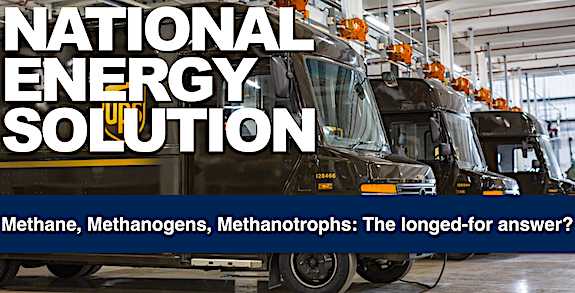National Energy Solution: Pt 1: Methane, methanogens, methanotrophs

Last week we reported that T2C Energy in partnership with the US Department of Energy had developed at pilot-scale a technology that makes drop-in transportation fuel for $2.91 a gallon, excluding any help from carbon prices and markets. (The techno-economics were validated by ICF, which is the gold standard in the bioenergy validation department). And we reported earlier this summer that a coalition quarterbacked by the Advanced Biofuels Association, working with EPA, has broken through on the biointermediates rule, allowing a Renewable Fuel Standard qualifying product to be produced at two or more facilities — such as a preprocessing site and a finishing site.
Let’s put these two together into a National Energy Solution
For a number of years, w e have seen astonishing growth in anaerobic digester facilities in the US, which are primarily producing renewable methane from agricultural and animal waste for heat and power markets. Locally, it can be used as biogas to generate heat; purified, it can be injected into the US natural gas pipeline system, which was built for fossil methane but handles biomethane just fine.
So, we have three components of a national energy solution: 1: a technology to convert biomass into a transportable gas; 2; an existing market in heat and power to support the development and deployment of the technology; 3; a built-in system to transport that gas to existing refineries and end-use customers; and 4: a biointermediates rule that will now permit the conversion of that methane feedstock into a second, alternative fuel.
The T2C Energy Project
The appearance of the T2C Energy project, and the validation of the economics, could not come at a better time. Now, we have the vital 5th component of our National Energy Solution. We have the ability to make an affordable fuel.
We’re not done developing, but consider the advantages of the system already outlined.
1. We have affordable fuel.
2. We bypassed the solids to liquids conversion problem, which great technologists have worked on for years and it remains a great hurdle in bioeconomy development.
3. We simplified the problem of moving biomass, since we’re injecting it into the pipeline system. As long as there is strict and accurate accounting of the RNG entered into the pipeline and the withdrawals at the refining site by the fuel producer.
$. We have lowered our carbon footprint, since we do not have to transport all the molecules all the way. It is enough that they are on the pipeline, as long as the pipe connects the source and the refiner. Just as when we buy natural gas in Maine and use it in Oregon, we are not actually transporting the molecules across the country,
6. We have good carbon accounting, because are booking the order and we use a secure ledger to ensure that the right amount of gas is put in and removed.
7. We have solved the biomass feedstock availability problem, because we can access every one fo the billion tons of affordable, available biomass outlined in the Billion Ton Study. As long as we make it wet enough and small enough, we can use microbes to convert agricultural, animal, municipal and forest waste as well as purpose grown energy crops raised on marginal land.
Resilience through Diversification
The next step, you may have guessed already. To make our system more resilient and less susceptible to swings in commodity prices, fuel demand and public acceptance, why not add-on modules that will convert our methane, when the economics is right, to feed or to chemicals and materials?
For that we look beyond the world of methanogens that make methane from biogenic feedstocks like dairy waste, and over to methanotrophs that use methane as the feedstock and produce useful products such as single-cell protein. If we work in the field of gas fermentation we have to learn precise bioproduction skills, but companies such as LanzaTech have proved beyond a shadow of a doubt that gas fermentation works as an everyday, real-world technology platform.
Calysta, iMicrobes, Mango Materials, Oberon
Three companies come to mind. In feed, what about Calysta? Here’s a company that makes single-cell protein at commercial scale, using methanotrophs. Want to move beyond feed and into the world of higher-value materials and chemicals to provide those to all our brands making Net Zero pledges to their customers? Think iMicrobes and Mango Materials out of the Bay Area. And what of Oberon, which makes bio-DME and is shipping commercial volumes using raw biogas as a feedstock.
The list of companies does not end for all time with these four, but we’ve admired them for a long time, so let’s start there.
What have we built?
We have sustainable, affordable, reliable, available drop-in transport fuels. Should demand dip or prices collapse, we can shift to sustainable materials, chemicals, or feed. If all else fails, we still have RNG for the power and heat markets, same as we started with.
We can produce our methane right next to the source, convert it at any refining point we choose that is connected to the pipeline system and we might even pursue more economies of scale in refining than in possible when biomass sourcing and refining must take place at the same site. We have found a way to minimize our carbon score because we are not moving solid biomass full of oxygen in the carbohydrates and in the water content.
We have a resilient Solution that makes energy, can be executed at national scale, and at affordable prices. That’s why this is a National Energy Solution.
More on the story
We’ll be looking in more depth at T2C Energy this week in The Digest.
Category: Top Stories















